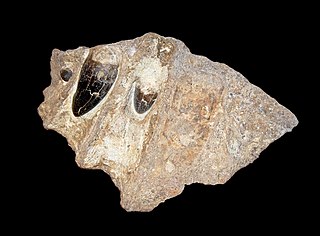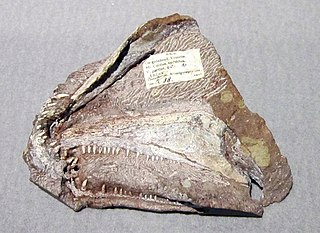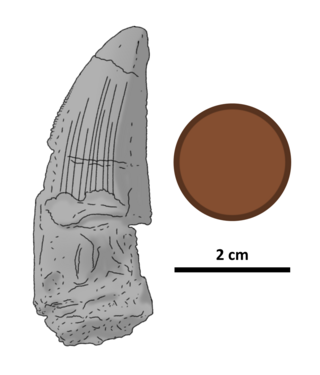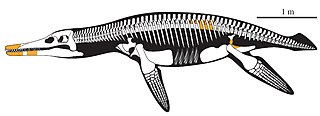
Serration is a saw-like appearance or a row of sharp or tooth-like projections. A serrated cutting edge has many small points of contact with the material being cut. By having less contact area than a smooth blade or other edge, the applied pressure at each point of contact is greater, and the points of contact are at a sharper angle to the material being cut. This causes a cutting action that involves many small splits in the surface of the material being cut, which cumulatively serve to cut the material along the line of the blade.

Dentinogenesis imperfecta (DI) is a genetic disorder of tooth development. It is inherited in an autosomal dominant pattern, as a result of mutations on chromosome 4q21, in the dentine sialophosphoprotein gene (DSPP). It is one of the most frequently occurring autosomal dominant features in humans. Dentinogenesis imperfecta affects an estimated 1 in 6,000-8,000 people.

Zapsalis is a genus of dromaeosaurine theropod dinosaurs. It is a tooth taxon, often considered dubious because of the fragmentary nature of the fossils, which include teeth but no other remains.

Siamosaurus is a genus of spinosaurid dinosaur that lived in what is now known as China and Thailand during the Early Cretaceous period and is the first reported spinosaurid from Asia. It is confidently known only from tooth fossils; the first were found in the Sao Khua Formation, with more teeth later recovered from the younger Khok Kruat Formation. The only species Siamosaurus suteethorni, whose name honours Thai palaeontologist Varavudh Suteethorn, was formally described in 1986. In 2009, four teeth from China previously attributed to a pliosaur—under the species "Sinopliosaurus" fusuiensis—were identified as those of a spinosaurid, possibly Siamosaurus. It is yet to be determined if two partial spinosaurid skeletons from Thailand and an isolated tooth from Japan also belong to Siamosaurus.
Ferganocephale is a dubious genus of neornithischian dinosaur. It was from the Middle Jurassic Balabansai Svita of Kyrgyzstan. The type and only species is F. adenticulatum.

Pectinodon is a genus of troodontid theropod dinosaurs from the end of the Maastrichtian age of the Late Cretaceous period (66 mya). It currently contains a single valid species, Pectinodon bakkeri, known only from teeth.

Crosbysaurus is a genus of extinct archosauromorph that lived in the Late Triassic of Arizona, New Mexico, North Carolina, Texas, and Utah. It is known from the Chinle Formation and Dockum Group rock units from the southwestern United States. The type species is C. harrisae, and the only known material includes teeth. 11 specimens are known, each including a single tooth.

Dromaeosauroides is a genus of dromaeosaurid theropod dinosaur from the Early Cretaceous of what is now Denmark and possibly also England. It was discovered in the Jydegaard Formation in the Robbedale valley, on the island of Bornholm in the Baltic Sea. This is the only likely place for dinosaur remains to be discovered on Danish territory, since the Mesozoic deposits exposed in the rest of the country are marine. Dromaeosauroides is the first known dinosaur from Denmark, and the only one which has been scientifically named. It is one of the oldest known dromaeosaurs in the world, and the first known uncontested dromaeosaur from the Early Cretaceous of Europe.

Sharks continually shed their teeth; some Carcharhiniformes shed approximately 35,000 teeth in a lifetime, replacing those that fall out. There are four basic types of shark teeth: dense flattened, needle-like, pointed lower with triangular upper, and non-functional. The type of tooth that a shark has depends on its diet and feeding habits.

Razanandrongobe is a genus of carnivorous ziphosuchian crocodyliform from the Middle Jurassic of Madagascar. It contains the type and only species Razanandrongobe sakalavae, named in 2004 by Simone Maganuco and colleagues based on isolated bones found in 2003. The remains, which included a fragment of maxilla and teeth, originated from the Bathonian-aged Sakaraha Formation of Mahajanga, Madagascar. While they clearly belonged to a member of the Archosauria, Maganuco and colleagues refrained from assigning the genus to a specific group because the fragmentary remains resembled lineages among both the theropod dinosaurs and crocodylomorphs.

A tooth is a hard, calcified structure found in the jaws of many vertebrates and used to break down food. Some animals, particularly carnivores and omnivores, also use teeth to help with capturing or wounding prey, tearing food, for defensive purposes, to intimidate other animals often including their own, or to carry prey or their young. The roots of teeth are covered by gums. Teeth are not made of bone, but rather of multiple tissues of varying density and hardness that originate from the outermost embryonic germ layer, the ectoderm.

Xixiasaurus is a genus of troodontid dinosaur that lived during the Late Cretaceous Period in what is now China. The only known specimen was discovered in Xixia County, Henan Province, in central China, and became the holotype of the new genus and species Xixiasaurus henanensis in 2010. The names refer to the areas of discovery, and can be translated as "Henan Xixia lizard". The specimen consists of an almost complete skull, part of the lower jaw, and teeth, as well as a partial right forelimb.

Uatchitodon is an extinct genus of Late Triassic reptile known only from isolated teeth. Based on the structure of the teeth, Uatchitodon was probably a carnivorous archosauromorph. Folded grooves on the teeth indicate that the animal was likely venomous, with the grooves being channels for salivary venom. The teeth are similar to those of living venomous squamates such as Heloderma and venomous snakes. Uatchitodon is the earliest known venomous reptile.

Ymeria is an extinct genus of early stem tetrapod from the Devonian of Greenland. Of the two other genera of stem tetrapods from Greenland, Acanthostega and Ichthyostega, Ymeria is most closely related to Ichthyostega, though the single known specimen is smaller, the skull about 10 cm in length. A single interclavicle resembles that of Ichthyostega, an indication Ymeria may have resembled this genus in the post-cranial skeleton.

Ostafrikasaurus is a genus of theropod dinosaur from the Late Jurassic period of what is now Lindi Region, Tanzania. It is known only from fossil teeth discovered sometime between 1909 and 1912, during an expedition to the Tendaguru Formation by the Natural History Museum of Berlin. Eight teeth were originally attributed to the dubious dinosaur genus Labrosaurus, and later to Ceratosaurus, both known from the North American Morrison Formation. Subsequent studies attributed two of these teeth to a spinosaurid dinosaur, and in 2012, Ostafrikasaurus crassiserratus was named by French palaeontologist Eric Buffetaut, with one tooth as the holotype, and the other referred to the same species. The generic name comes from the German word for German East Africa, the former name of the colony in which the fossils were found, while the specific name comes from the Latin words for "thick" and "serrated", in reference to the form of the animal's teeth.

Pulp stones are nodular, calcified masses appearing in either or both the coronal and root portion of the pulp organ in teeth. Pulp stones are not painful unless they impinge on nerves.

Denticles, also called serrations, are small bumps on a tooth that serve to give the tooth a serrated edge. In paleontology, denticle characteristics such as size and density are used to describe and classify fossilized teeth, especially those of dinosaurs. Denticles are also present on the teeth of varanoid lizards, sharks, and mammals. The term is also used to describe the analogous radular teeth of mollusks.

Makhaira rossica is an extinct genus and species of a marine reptile belonging to the family Pliosauridae. It lived during the early Cretaceous period, and its fossils have been found in Russia.

Andersonerpeton is an extinct genus of aïstopod from the Bashkirian of Nova Scotia, Canada. It is known from a single jaw, which shares an unusual combination of features from both other aistopods and from stem-tetrapod tetrapodomorph fish. As a result, Andersonerpeton is significant for supporting a new classification scheme which states that aistopods evolved much earlier than previously expected. The genus contains a single species, A. longidentatum, which was previously believed to have been a species of the microsaur Hylerpeton.
Syntomiprosopus is an extinct genus of archosauriform, possibly a crocodylomorph from the Late Triassic period of Arizona. The type and only known species is S. sucherorum. Syntomiprosopus was unusually short-snouted, comparable to the Late Cretaceous notosuchian Simosuchus, and is regarded as an example of convergent evolution between Triassic stem-archosaurs and Cretaceous archosaurs.

















